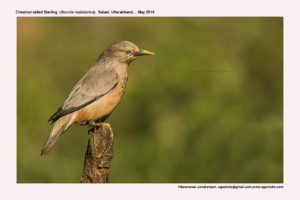
Chestnut-tailed Starling Sturnia malabarica
Etymology :
- Sturnia : Latin word for starling
- Malabarica : From Malabar reigon in India
Distribution in India: Resident of Eat and North East of India, Winter visitor in peninsular India and Summer visitor in Central & Northern Himalayas.
Description: Size of 19-20 cm. It has white forehead and chin .The crown, nape and side of head are silver-grey with pale feather shafts ,producing streaked appearance ; upperparts are grey, rump is orange-brown; upper wing-coverts are grey, tinged brownish, primaries are brown, darker and with green gloss on outer webs, primary coverts are black with green gloss, secondaries are brown, grey margins on outer webs . The tail is grey, retrices are tipped chestnut, more broadly on outer feathers, outermost retrices is wholly chestnut. The throat is cinnamon with white feather shafts producing streaking; breast, belly and vent are rich cinnamon-brown, under tail-coverts are variable, partly or sometimes wholly white. The iris is greyish-white; bill is yellow at tip, green in middle, blue at base; legs are brownish-yellow or olive-brown. Both sexes look alike.
Habitat: It is found in open deciduous forest, scrub, and cultivated areas near human habitation; especially fond of waterlogged areas,lowlands and hills
Food Habits: It eats insects like caterpillars, beetles, termites, bees, flies, bugs and earwigs. They also eat seeds & fruit like figs and also nectar. The nestlings are fed mainly with insects, particularly caterpillars and beetles. It is highly arboreal, foraging with great agility in fine branches in flowering trees, gleaning insects. It forages also in low bushes and occasionally on ground.
Breeding Habits: They breed in Apr–Jul .They are Monogamous. They make a nest of grass, rootlets and twigs, placed by both parents in tree hole, often old hole of Woodpecker or Barbet. They lay a clutch of 3–5 eggs. Both male and female participate in incubation of eggs and feeding of chicks. The incubation period is 12 days. The nestling period is 18–21 days